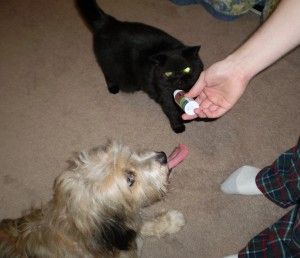By Roslyn Ayers, PetSafe Web Content Specialist
When I first considered bringing a dog into our all-cat home, the first thing I was worried about was getting the cats used to a dog. None of our 4 cats had ever spent much time with dogs, so naturally they were all terrified of them. The cats came first, so we wanted to make sure we got a dog who would understand that. I did a lot of research to make sure we introduced them the right way. 
Some cats and dogs can get along just fine!
Tips for the Dog
- Exercise your dog before the first introduction
- Keep the dog on a leash
- Monitor all interactions
- Give a quick correction if the dog starts to chase the cat
- Keep them separated by a crate or baby gate
Tips for the Cat
- Provide opportunities to escape
- Don’t force interactions
- Give your cat time to get used to the dog
- Watch out for clawing
Before we brought Doc home, we did a little practice desensitizing them to dogs. My sister brought over her dogs, and we had her dogs sit quietly in the living room. The cats eventually wandered into the room out of curiosity, so we just let them look at each other. We were trying to teach the cats that dogs won’t cause them any harm.
I used some of the cats’ favorite treats to lure them out next to the dogs. Our most treat-motivated cat came out of hiding for a Lickety Stik, and since one of my sister’s dogs loves Lickety Stik too, we started edging them closer to each other by holding the treat closer and closer. Eventually Renji the cat was licking the treat at the same time as the dog! The rest weren’t quite as comfortable with the dogs, but at least they got some exposure to them. 
Sharing a Lickety Stik helped bring Renji and Doc closer together!
When we brought Doc into our house after the adoption was finalized, we tossed the tennis ball for him in the backyard for a while to tire him out. We didn’t want him to have too much energy when meeting the cats for the first time. He’s a playful, energetic guy, so I thought he might chase the cats to play with them.
Doc didn’t seem to want to chase the cats in a mean way; he was just very interested in sniffing the cats, which they viewed as an invasion of their “personal space.” We kept him on a leash to make sure he couldn’t go after the cats. If your dog uses a crate, you could put the dog in his kennel and let the cats come up to him to check him out. We kept their initial interactions short and pleasant, never forcing the cats to come closer. After a few days, we took off the leash but kept Doc close to us and made sure to watch carefully for any signs of interest in the cats.
Any time he started to chase after the cats, a quick “Doc, no!” brought his attention back to me. If your dog is more adamant about chasing, keep him on the leash for a little longer and give a specific command, such as “No chase” or “Leave it.” Give your dog a treat every time he sees the cat and doesn’t start running. 
Lily’s curiosity eventually won out over her fear of Doc.
We made sure to give the cats plenty of space and time to get used to him. Since the cats were used to sleeping with us, we made Doc sleep in the kitchen, separated from the cats by pet gates. The cats didn’t have to change their nighttime routine, they got a chance to sniff him safely on the other side of the gate, and they got a break from having the dog around us all the time.
Luckily Doc doesn’t have any problems with separation anxiety, so this didn’t bother him. You could also try keeping your dog in his crate in the bedroom, so he is close enough to you to be comforted and kept separated from the cat.
The cats helped put Doc in his place too. After a few weeks, when they got comfortable enough to be in the same room as him, if he got too close or sniffed them for too long, they would meow or hiss and whack him on the nose. The warning tap to stop bothering them quickly taught Doc to leave them alone. Keep a close eye on your cats to see if they warn your dog too roughly though; some cats will use their claws, which can injure your dog or cause your dog to bite back.
The cats tolerate Doc now, and Doc understands the pecking order of the house. We feel comfortable leaving them alone without worrying about their safety. The only problem we have now is finding room for all of them on the couch!
Do you have any tips for getting cats and dogs to get along? Post them in the comments below!
ABOUT ROSLYN
At PetSafe’s Knoxville headquarters, Roslyn Ayers is the Web Content Specialist. Roslyn comes from a family of animal lovers and has a B.A. in Writing/Communications from Maryville College. She has volunteered with various animal rescues in Tennessee and South Carolina. Roslyn currently shares her home with four cats and her dog, Doc.


